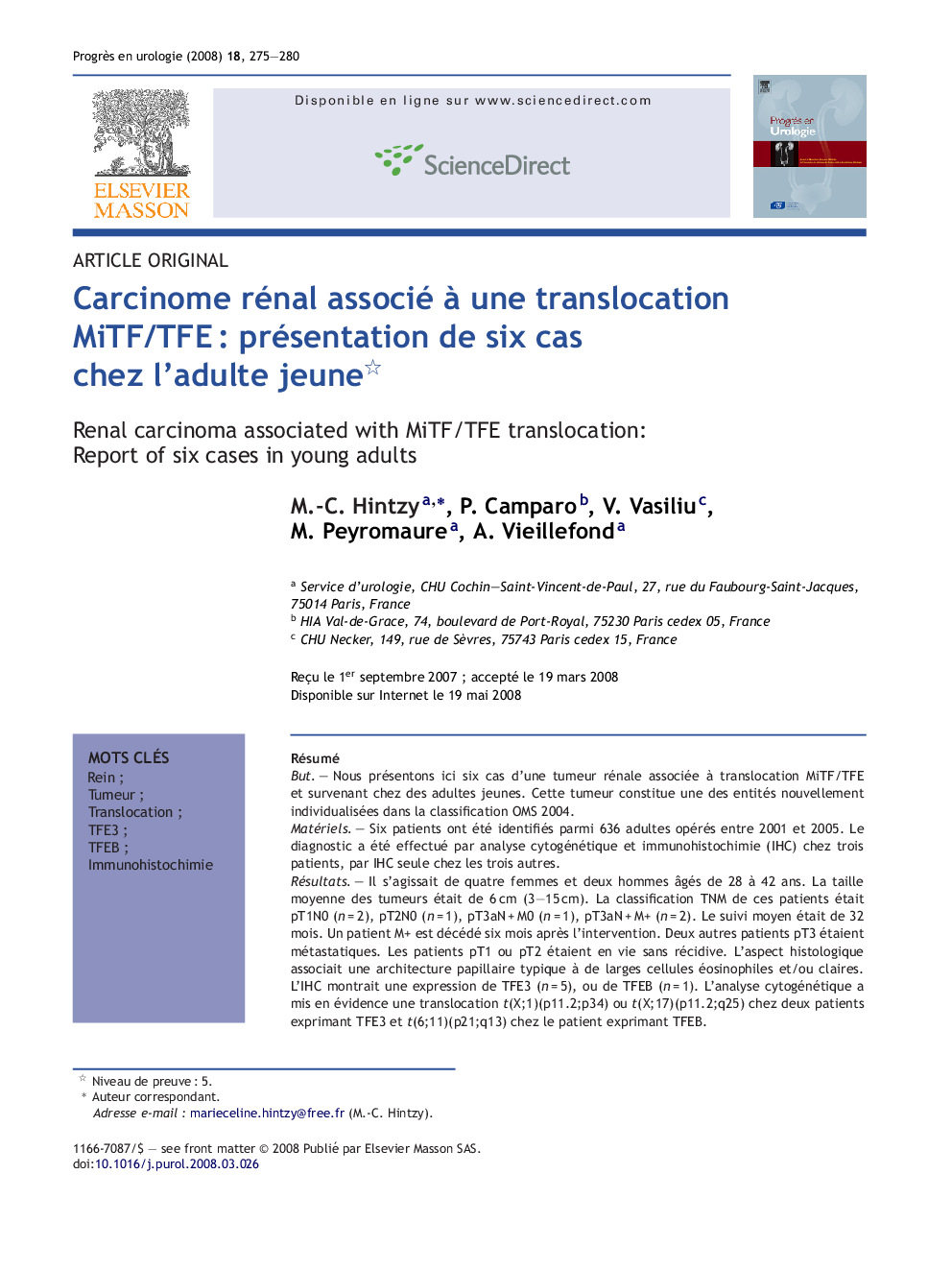| Article ID | Journal | Published Year | Pages | File Type |
|---|---|---|---|---|
| 3824123 | Progrès en Urologie | 2008 | 6 Pages |
RésuméButNous présentons ici six cas d’une tumeur rénale associée à translocation MiTF/TFE et survenant chez des adultes jeunes. Cette tumeur constitue une des entités nouvellement individualisées dans la classification OMS 2004.MatérielsSix patients ont été identifiés parmi 636 adultes opérés entre 2001 et 2005. Le diagnostic a été effectué par analyse cytogénétique et immunohistochimie (IHC) chez trois patients, par IHC seule chez les trois autres.RésultatsIl s’agissait de quatre femmes et deux hommes âgés de 28 à 42 ans. La taille moyenne des tumeurs était de 6 cm (3–15 cm). La classification TNM de ces patients était pT1N0 (n = 2), pT2N0 (n = 1), pT3aN + M0 (n = 1), pT3aN + M+ (n = 2). Le suivi moyen était de 32 mois. Un patient M+ est décédé six mois après l’intervention. Deux autres patients pT3 étaient métastatiques. Les patients pT1 ou pT2 étaient en vie sans récidive. L’aspect histologique associait une architecture papillaire typique à de larges cellules éosinophiles et/ou claires. L’IHC montrait une expression de TFE3 (n = 5), ou de TFEB (n = 1). L’analyse cytogénétique a mis en évidence une translocation t(X;1)(p11.2;p34) ou t(X;17)(p11.2;q25) chez deux patients exprimant TFE3 et t(6;11)(p21;q13) chez le patient exprimant TFEB.ConclusionLe diagnostic de carcinome associé à translocation MiTF/TFE a pu être réalisé par IHC. Cependant, l’étude cytogénétique sur matériel frais ou congelé a permis de caractériser la translocation et devrait être réalisée pour toute tumeur rénale de l’adulte jeune. Le pronostic était lié au stade. À l’avenir, le diagnostic d’un plus grand nombre de ce type de carcinomes permettra de mieux préciser leur profil anatomoclinique et d’adapter la prise en charge.
SummaryObjectiveThe authors present six cases of renal carcinoma associated with MiTF/TFE translocation in young adults. This tumour is one of the newly identified entities of the WHO 2004 classification.MaterialsSix patients with MiTF/TFE translocation were identified in a series of 636 adults operated between 2001 and 2005. The diagnosis was based on cytogenetic analysis and immunohistochemistry (IHC) in three patients and IHC alone in the other three patients.ResultsFour women and two men between the ages of 28 and 42 years presented a tumour with a mean diameter of 6 cm (range: 3–15 cm). The TNM classification of these tumours was pT1N0 (n = 2), pT2N0 (n = 1), pT3aN + M0 (n = 1), and pT3aN + M+ (n = 2). The mean follow-up was 32 months. One M+ patient died six months after the operation, another two pT3 patients developed metastatic disease and pT1 or pT2 patients were alive without recurrence. The histological features comprised a typical papillary architecture with large eosinophil and/or clear cells. IHC showed TFE3 (n = 5) or TFEB (n = 1) expression. Cytogenetic analysis demonstrated a t(X;1)(p11.2;p34) or t(X;17)(p11.2;q25) translocation in two patients expressing TFE3 and a t(6;11)(p21; q13) translocation in the patient expressing TFEB.ConclusionRenal carcinoma associated with MiTF/TFE translocation can be diagnosed by IHC. However, cytogenetic analysis on fresh or frozen material allows characterization of the translocation and should be performed on all renal tumours in young adults. Prognosis is related to stage. In the future, the diagnosis of more cases of this type of carcinoma will allow more precise definition of the clinicopathological profile and the most appropriate management.
